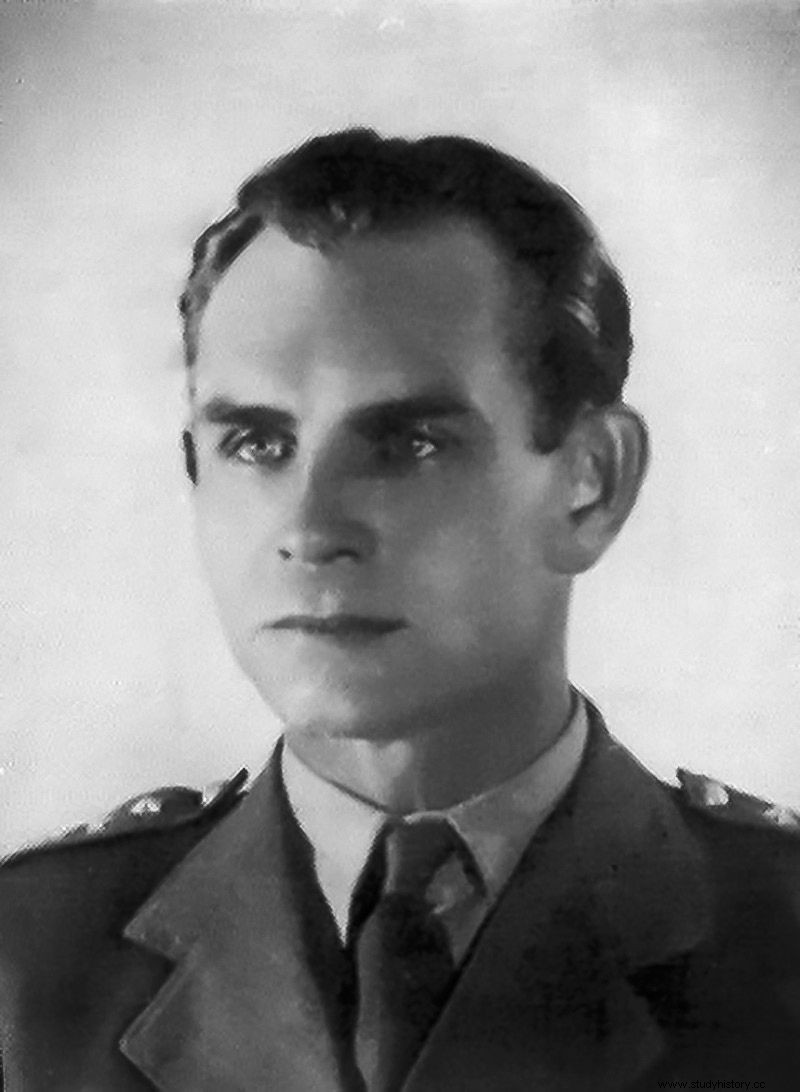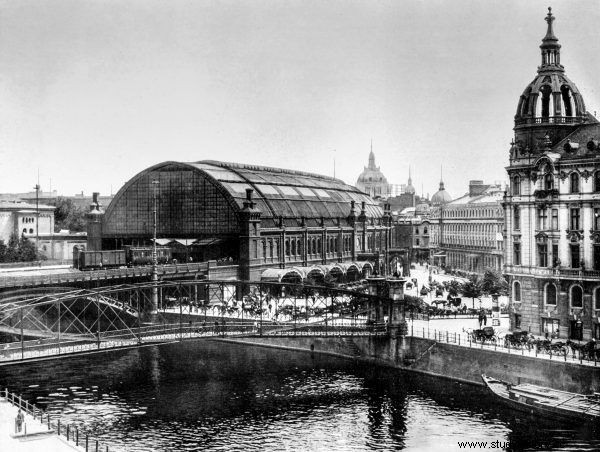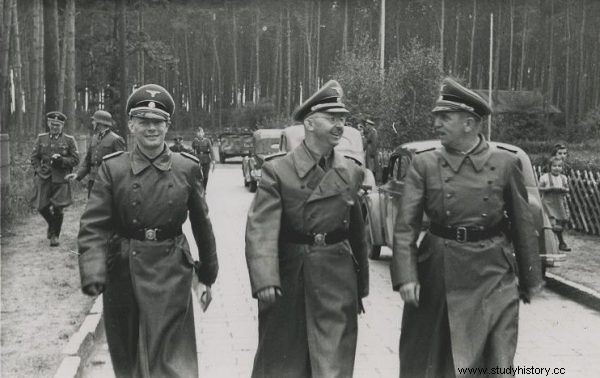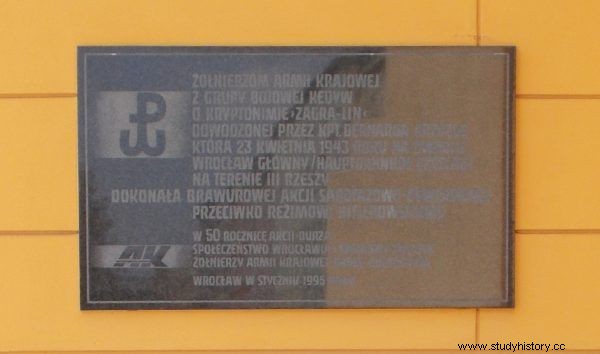The intelligence cells of the Home Army reached deep into Germany. In the enemy's territory, ours conducted an uncompromising propaganda campaign. But not only. Right under Hitler's nose, they also organized spectacular bombings.
During World War II, the Polish underground carried out a number of such activities. In Berlin alone, in the years 1940-1943, a dozen or so Polish bombs exploded. The attacks at the railway stations in Berlin and Breslau (Wrocław) carried out by the Zagra-Lin branch in the first half of 1943 were the most strongly inscribed in the history of the Home Army. Despite several publications on the subject, many issues still need to be clarified.
"Zagra-Lin" was established in December 1942 as part of the Organization of Special Combat Actions, codenamed "Osa" - "Kosa 30", which was a unit for special tasks of the Home Army Commander, and then Kedyw of the Main Headquarters. The purpose of the new unit, commanded by Lieutenant Bernard Drzyzga, pseudonym "Bogusław-Jarosław", there was a diversion in the territories of the Third Reich and Polish lands incorporated into Germany. In one of the periodic reports of the Home Army Commander to the Staff of the Commander-in-Chief, we read:
Organizational work in its early stages. A legalization cell for the needs of the District Headquarters of Berlin and KG was launched, a cell for communication with workers' clusters and a terrorist cell headed directly by Kedyw KG .
AK hits Hitler under his nose
The branch quickly moved from the organizational phase to the operation. Much of the credit goes to Deputy Drzyzga, Józef Lewandowski "Jura", who hired a few people from Bydgoszcz and Kalisz. He was among them, among others his brother Jan pseud. "Jan" and cousin Wojciech Lewandowski pseud. "Wojciech", who took command of the Bydgoszcz section. The first actions involved retaliatory bombing operations in German cities.

Bernard Drzyzga ps. "Bogusław-Jarosław".
The inaugural strike took place on February 13, 1943 at the S-Bahnhof Friedrichstrasse in Berlin. The place was chosen not by accident. The station was one of the busiest in the German capital, and the largest group of passengers were officers from the Gestapo, SS and other police and military formations.
The action was carried out by "Jur" and three of his subordinates from Bydgoszcz:"Jan", Janusz Łuczkowski "Mały" and Leon Hartwig "Leon". The bomb has been specially crafted to enhance the firepower. German losses are difficult to determine. In his book about the branch, Drzyzga indicated in one place that 36 people had died and 78 were wounded. In another excerpt he gave the number of 4 killed and 60 wounded.
It must be admitted that the German authorities must have been deeply moved by the attack in the heart of Berlin, since the head of the Gestapo SS-Gruppenführer Heinrich Müller was appointed to investigate the matter. Suspicions fell on the Polish underground. Even Berlin newspapers wrote about increased vigilance towards Poles appearing in the city. However, it ended with clues and guesswork.

You can read about other successes of the soldiers of the Polish underground in the book by Wojciech Königsberg entitled "AK 75. Daring actions of the Home Army" (Znak Horyzont 2017).
The highly rated action "Jura" convinced the command of the Home Army of the need to conduct this type of retaliation. Lewandowski was trained by Cichociemny Lieutenant Ewaryst Jakubowski "Brother" in the use of English plastic to create explosives. In April, it's time for another strike. This time the action was led personally by "Bogusław-Jarosław". The cargo was planted on April 10 at Berlin's main station on Friedrichstrasse.
As planned, the explosion took place 2 minutes after 7 am, when passengers of military trains were on the platform. As Drzyzga recalled:
I heard two trains approaching the station. Suddenly they stopped. I looked at my watch and started counting ... Three seconds ... Two ... One and turned towards the station to see the effect. Suddenly there was a huge flash above the station, followed by hundreds of smaller flashes, until a long tongue of red-orange fire covered the roof of the building. At that very moment there was a terrible explosion that shook the pavement on which I stood. I quickened my pace. Soon I heard terrible screams, cries, orders and calls. Panic engulfed everyone at the station. Alarm sirens blew. The police went to action and the platform exits were closed .

Friedrichstrasse station in Berlin in a period photo.
As a result of the explosion, 14 people were killed and 60 were injured. The Gestapo blindly arrested every suspect. There was a high reward for identifying the perpetrators. At the behest of Adolf Hitler, the investigation was taken over by Reichsführer-SS Heinrich Himmler. But it was still like looking for a needle in a haystack, and it didn't work.
Goal Wrocław
While the search for the perpetrators was in progress in Berlin, "Zagra-Lin" made another well-aimed strike. This time the site of the attack was the main station in Wrocław. According to Drzyzga, the action took place on April 23. The explosion happened just below an oncoming military train. Four people died and a dozen were injured. Despite the police blockade, the whole team safely returned to Warsaw.
For his bravery and well-conducted strikes, Drzyzga was promoted to the rank of captain and the Order of Virtuti Militari. Virtuti also received the "Jur". The remaining saboteurs were awarded the Crosses of Valor.

The perpetrators of "Zagra-Lin" could not be found, despite his personal involvement in the case of Heinrich Himmler. Pictured during the visit to the SS-Truppenübungsplatz Heidelager Pustków concentration camp.
There are many unknowns about the shares in Berlin and Wrocław. It is enough to look at the announcement of the Command of the Underground Struggle placed on July 1, 1943 in the "Information Bulletin":
As part of a general bestial retaliation (sic!) German in Poland, in particular for the murder of 189 Poles in Poznań and the massacre of 94 prisoners from Pawiak executed on May 7 this year. - on 10-May 1943 at 9 p.m. 2 bombs were detonated at the Silesian railway station in Berlin, and on 12 May 1943, at 9:30 p.m. at the railway station in Wrocław - one bomb. As a result of the acts of 15 Germans were killed and 26 wounded .
The date of the action in Berlin differs from that indicated by Drzyzga by exactly one month. However, as for Wrocław, according to the announcement, the explosion took place on May 12, and not on April 23. As rightly noted by Bogdan Kobuszewski, who thoroughly analyzed Polish sources on this subject, bombing operations in the Third Reich require verification in terms of dates and places of execution, as well as in personnel and organizational matters. Of course, the best method is to confront the Polish findings with the German documentation produced during the war.

A plaque dedicated to "Zagra-Lin", located on the building of the Wrocław Główny railway station.
Accurate strikes of the Home Army greatly irritated the Germans. The occupant was doggedly following the perpetrators of the bombing operations. On June 5, 1943, in the church of St. Aleksandra on pl. Trzech Krzyży in Warsaw, the Gestapo arrested several dozen members of "Kosa 30". According to a German report, the arrests were aimed at the soldiers of "Zagra-Lin" and members of "Kosa 30" who, in April 1943, made an unsuccessful attempt to liquidate the higher SS and police commander in the General Gouvernement of SS-Obergruppenführer Friedrich Krüger. It was the actual end of the ward.
***
You can read about other successes of the soldiers of the Polish underground in the book by Wojciech Königsberg entitled AK 75. Daring actions of the Home Army Which will be available on October 25th.
